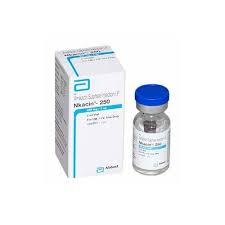Here is a complete, clear overview of:
💉 Amikacin Injection 250 mg/mL
🌿 Nature / Drug Class:
- Amikacin is a broad-spectrum aminoglycoside antibiotic
- Acts by inhibiting protein synthesis in bacteria (bactericidal)
- Effective mainly against aerobic gram-negative bacteria, some gram-positive, and resistant organisms
🎯 Purpose / Indications:
Used in hospital settings to treat serious bacterial infections like:
- Sepsis / Septicemia
- Hospital-acquired pneumonia
- Complicated urinary tract infections (UTI)
- Intra-abdominal infections
- Skin, soft tissue, bone & joint infections
- Post-operative or ICU infections
- Multidrug-resistant tuberculosis (as second-line drug)
✅ Advantages:
- Higher concentration (250 mg/mL) allows smaller volume administration
- Strong effect against resistant gram-negative organisms (Pseudomonas, Acinetobacter, Klebsiella)
- Often combined with beta-lactam antibiotics for broader coverage
- Reliable in critically ill or ICU patients
💉 Form & Administration:
- Strength: 250 mg/mL
- Common vial: 2 mL vial = 500 mg total dose
- Given via:
- Intramuscular (IM) injection
- Intravenous (IV) injection or infusion
- Dosage:
- Adults: Typically 15 mg/kg/day, divided every 12 hours
- Children & neonates: Dose adjusted by weight and condition
- Kidney disease patients: Dose & interval must be adjusted
📦 Common Packaging:
- Glass vial, 2 mL volume (i.e., 500 mg total)
- Hospital kits or single-dose ampoules
⚠️ Patient Advice / Precautions:
- Used under supervision of a doctor, especially in ICU or serious infections
- Requires monitoring of blood levels, kidney function, and hearing tests
- Caution in:
- Kidney impairment
- Elderly patients
- Patients on loop diuretics or other nephrotoxic drugs
- Side effects:
- Nephrotoxicity (kidney damage – may be reversible)
- Ototoxicity (hearing or balance issues – sometimes permanent)
- Local pain or swelling at injection site
🧊 Storage:
- Store at 2°C to 8°C (Refrigerated)
- Do not freeze
- Protect from light
- Once opened, use immediately or as per hospital protocol

